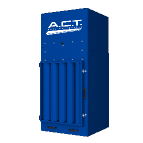
The Challenge of Torch Cutting Scrap Metal
Torch cutting in scrap yards is a physically demanding process, often performed under tough conditions. The task involves using hand-held torches to reduce large pieces of scrap metal into manageable sizes for remelting. While it's effective, the process generates substantial smoke and heat, making it a challenging job both environmentally and operationally.
Typically done in open spaces, torch cutting may seem simple but often clashes with environmental regulations. Agencies such as the EPA and OSHA have strict guidelines around air pollution, which can result in fines, shutdowns, or even lawsuits if not followed. Scrap yard operators are, therefore, forced to find ways to capture harmful particulates and smoke, ensuring compliance while keeping their operations running efficiently.
A Spectrum of Solutions: Torch Cutting Backdrafts vs. Enclosed Buildings
To mitigate the environmental risks of torch cutting, companies have two primary options: a torch cutting backdraft or a stationary/movable building. Both solutions require properly sized dust collection systems to capture smoke and particulates, but they differ significantly in cost, complexity, and operational impact.
1. Torch Cutting Backdrafts
Backdraft systems are a more cost-effective and timely solution. These partially enclosed structures are ducted to a dust collector, allowing operators to torch metal toward the booth, which captures approximately 80% of smoke and particulates, depending on wind conditions and proximity to the booth.
- Pros:
- Lower cost compared to a fully enclosed building.
- Shorter lead times and easier installation.
- Demonstrates a proactive approach to OSHA and EPA compliance.
- Cons:
- Operators are still exposed to weather conditions (rain, snow, heat).
- Limited capture distance, requiring multiple booths to ensure continuous workflow and reduce downtime.
2. Torch Cutting Buildings
While more labor-intensive and costly to implement, a torch cutting building—whether stationary or mobile—offers 100% smoke and particulate capture when equipped with the appropriate dust collection system. This solution allows for bulk processing of scrap metal on a mass industrial scale.
- Pros:
- Complete smoke and particulate capture.
- Optimized operational flow for large-scale processing.
- Cons:
- Higher initial cost.
- Longer lead time and significant space requirements.
Case Study: A.C.T.’s Torch Cutting Solution
One of A.C.T.’s clients was facing imminent shutdown due to excessive smoke and particulate emissions from their torch cutting operations. Over two years, the client tried various solutions from competitors but none met EPA or OSHA standards. Frustrated, they contacted A.C.T. to develop a compliant solution.
After conducting a comprehensive site visit, we worked closely with the client to design a tailored solution that minimized downtime and met regulatory requirements. The final design involved a 48,000 CFM, ACT 5-120 dust collector. From final drawing approval to installation, the process took just 3.5 months.
The results were immediate and effective. The system reduced emissions to compliant levels, allowing the client to avoid fines, shutdowns, and lawsuits. After two months of continuous operation, the filters had settled into about 30-40% of their lifecycle, with filter replacements scheduled every six months—a common cycle in high-output operations.
Why A.C.T. Succeeded Where Others Failed
Our approach wasn’t just about providing a product. We partnered with the client to fully understand their operation, spending hours in person refining the design. This included everything from formal presentations and CAD drawings to hands-on modeling, to visualize the solution. The result was a custom solution that fit both the operational needs and regulatory demands of the client.
The Importance of Proactive Solutions
While a full torch cutting building is the ideal long-term solution for many operations, it may not always be feasible immediately. In such cases, implementing a torch cutting backdraft as a temporary or supplementary measure can be a smart move. Not only does it satisfy immediate regulatory requirements, but it also allows time to design and implement a more permanent building solution, using components like dust collectors that can be repurposed later.
As a CEO, safeguarding your operation from fines and shutdowns is critical, and proactive solutions ensure business continuity while keeping regulatory bodies at bay. While compliance may seem like a challenge, the right partner can turn it into a competitive advantage. A.C.T. can help guide you through the complexities of meeting environmental standards while maximizing operational efficiency.
NEXT STEPS
If your scrap yard is facing regulatory pressure or looking for ways to enhance your torch cutting operations, reach out to A.C.T. for a tailored consultation. Let us help you design a solution that protects both your business and the environment. Contact us today to discuss industrial dust collection for your application!



























%20Collectors%20Image.png?width=143&height=143&name=ADC%20(Ambient)%20Collectors%20Image.png)




























.png?width=240&height=91&name=ACT%20Dust%20Collectors%20Logo%20Solid%20White%202020%20(1).png)
.png?width=148&height=149&name=usa-manufactured-dust-collectors%20(1).png)